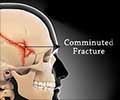New synthetic material called hyperelastic bone could be the next breakthrough in reconstructive surgery as it may be a powerful new tool for reconstructing skull defects.

‘3D-printed hyperelastic bone could be the future of reconstructive surgery as the new material may help in the growth and regeneration of new bone.’
Read More..




The experimental material accelerates bone regeneration across skull defects in rats, according to initial results by Ramille N. Shah, Ph.D., and colleagues of Northwestern University and the University of Illinois Health, Chicago. Read More..
The researchers write, "Hyperelastic bone has significant potential to be translated to craniofacial reconstructive surgery, where the need for cost-effective bone replacement grafts is enormous."
Promising New 3D-Printed Bone Replacement for Skull Reconstruction
The researchers report initial experiments with hyperelastic bone in rats with surgically created defects of the top of the skull. The surgically created defects were of a "critical size" unlikely to heal on their own - similar to those seen in patients who have undergone surgery for brain tumors.
Hyperelastic bone is a "3D-printed synthetic scaffold," consisting mainly of bone mineral (hydroxyapatite) plus a widely used, biocompatible material (polyglycolic acid). Hyperelastic bone consists of an intricate latticework, designed to support the growth and regeneration of new bone. It[TO1] can be quickly and inexpensively produced using current 3D printing hardware platforms and is malleable enough to be press-fit or cut into shape during surgery.
Advertisement
The 3D-printed hyperelastic bone provided good bone regeneration. On follow-up CT scans, the hyperelastic bone was about 74 percent effective after eight weeks and 65 percent at 12 weeks, compared to autologous bone. In contrast, defects treated with the polyglycolic acid scaffold showed little new bone formation.
"Hyperelastic bone has significant potential to be translated to craniofacial reconstructive surgery, where the need for cost-effective bone replacement grafts is enormous," Dr. Shah and colleagues conclude. With further development, they believe this 3D-printed material may provide a valuable alternative to the autologous bone and commercially available bone substitutes.
"Our study underscores the promising translational potential of this novel strategy for tissue engineering applications, particularly bone regeneration," the researchers add. They emphasize that further experimental studies will be needed to confirm the use of hyperelastic bone for specific types of craniofacial reconstruction.
Source-Eurekalert










